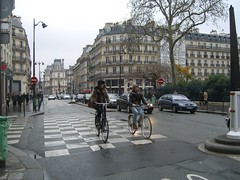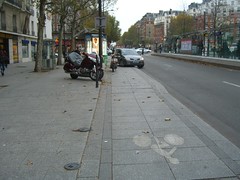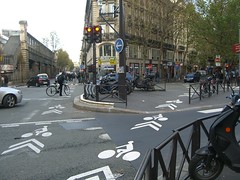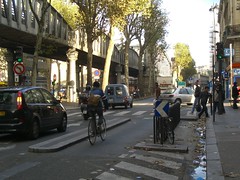I have spent the end of November in Paris. Of 2 weeks of my visit I’ve been riding a bike for 10 days: to explore the city, to get where I was going, in the morning, in the afternoon, in the evening, in dry weather and under drizzling rain. So I’ve got a lot of cycling impressions in the French capital and I’d like to share them with you. Here we go!
First of all I can say that Paris is definetely a bicycle city. What does it mean? It means that cyclists, bikes and bicycle facilities are clearly visible on the streets. People bike to work, to shops and cafés, wearing normal everyday clothes. Almost all the bicycles are city bikes. Road bikes are also present while cross-country ones are almost completely absent. A significant part of bicycle traffic is represented by Velib’ cyclists (parisian bike-share system).
Paris has a fairly good system of bicycle routes, connecting major city neighborhoods and suburbs. The authorities of the French capital started taking cycling seriously only in the late 1990s, so Paris is a beginner cycling city, comparing to cities in the Netherlands and Denmark and that makes it an interesting example of bicycle facilities’ evolution since a whole range of them is present: from mere compromise to rather impressive ones.
Since most of the streets don’t have any bicycle infrastructure significant distances have to be passed by cyclists in mixed traffic. To my mind parisian traffic, even if it looks chaotic and scary, is more or less friendly to cyclists. Nobody will honk and bypass you aggressively just to stop at a traffic light 15 seconds later. Cars try not to block the space to their right to allow cyclists pass if there’s a traffic jam. Drivers really look out for cyclists especially while turning right when conflicts are most likely to occur. On one hand this is due to overall friendliness of the French and good driving culture but on the other hand the cityscape itself enforce motorists to drive carefully. The streets are narrow with lots of traffic calming and safety improvements which restrain dangerous driving practices. Thus it is quite safe to ride with the traffic (and a lot of people do). Even passing some crazy parisian traffic circle like Place de la Bastille or Place de la Republique would not place you in grave danger.
But let’s pass to bicycle facilities finally, starting from the simpliest. The first one is a shared street. In general all streets are shared as I’ve stated above but there are some where the presense of cyclists is specially denoted. Usually these are service roads along major streets where bike routes are laid. Speed on these roads is limited to 30 km/h while markings and signs denote the bike route. Similar in conception I think are bicycle boulevards in some U.S. cities.
Another type of shared-use roads are bus lanes with bicycle access. There are plenty of them in Paris. These lanes are used not only by buses but also by taxis, however since they are fewer in numbers than private cars, these shared lanes can be counted as a good option. Bus lanes can be either marked with paint – these are valid only in certain hours – or protected with a curb. Physically protected bus lanes with bicycle access are 4.5 meters wide, so buses and taxis can safely overtake cyclists. Buses are even equipped with to sound signals – a horn to repel cars and a gentle bell to warn bicyclists and pedestrians.
The simpliest type of bicycle-only infrastructure is a painted bike lane. Bike lanes can either run along a curb or along a parking lane. In the latter case special markings are painted to denote a potentially dangerous door zone.
Painted bike lanes are often occupied by double-parked cars thus justifying the need for the next type of bicycle infrastucture – protected bike lanes. Functionally these are almost off-street bicycle paths but since they run on the surface of the carriageway they are to be called ‘lanes’. Curb-protected lanes rarely suffer from illegal parking (yet sometimes they do) thus being much more reliable for cyclists. This type of infrastructure is a good cost-effective alternative to bike paths since there’s no need to replace the pavement and the storm water drainage to install it.
A type of bike lanes which should be noted separately are counterflow lanes. These are lanes laid on one-way streets opposing the direction of mixed traffic. Streets in Paris are narrow and most of them are one-way. At the same time the street grid is so complex that going from A to B (even if they’re close to each other) can become painful. In this situation counterflow lanes provide cyclists with useful shortcuts thus improving bicycle’s attractiveness as a means of transport. At first sight these counterflow lanes seem dangerous, however I’ve found out that using them is rather safe since cyclists are in car drivers’ direct line of sight. Counterflow lanes can be either painted or curb-protected.
Bicycle paths – the top level of bicycle infrastructure – can be divided into 3 types. The first one is curbside bicycle path. From my point of view this type is the undesirable one. It is affected much more by illegal parking than protected bike lane. It is less pleasurable to ride on because the surface of the path bends everytime when it intersects with a driveway or a pedestrian crossing. At some point these drops and ramps become annoying.
The second type is a buffered bicycle path. The buffer zone between the carriageway and the bicycle path (usually around 2 meters wide) serves several functions. Firstly it separates cyclists and pedestrians from the moving traffic providing them with safe and dignified conditions. 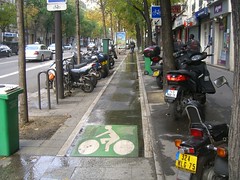 Secondly this zone accomodates a handful of useful streetscape elements like street trees; bicycle, scooter and car parking; light posts, bus stop shelters, traffic lights and signs, advertisements etc. Everything that is usually chaotically scattered along the sidewalk is carefully grouped here and doesn’t block the passage. Thirdly, buffer zone is used by pedestrians to wait for the green light while not blocking the bike lane. Pedestrians in general don’t see cyclists as a threat, so if a bike path is laid along the curb of the carriageway, pedestrians will use it as a waiting zone on the traffic lights. And fourthly, buffer zone is used for curb cuts thus saving the continuity of the bike path’s surface and improving the quality of cycling.
Secondly this zone accomodates a handful of useful streetscape elements like street trees; bicycle, scooter and car parking; light posts, bus stop shelters, traffic lights and signs, advertisements etc. Everything that is usually chaotically scattered along the sidewalk is carefully grouped here and doesn’t block the passage. Thirdly, buffer zone is used by pedestrians to wait for the green light while not blocking the bike lane. Pedestrians in general don’t see cyclists as a threat, so if a bike path is laid along the curb of the carriageway, pedestrians will use it as a waiting zone on the traffic lights. And fourthly, buffer zone is used for curb cuts thus saving the continuity of the bike path’s surface and improving the quality of cycling.
And the third type is a two-way bicycle path. These are rare in Paris so it’s really a pleasure to find one while going somewhere. Usually they are laid on rarely-used sidewalks and/or along some linear structures like railroads, canals, river embankments etc. For example the greenway along canal de l’Ourcq is more than 20 km long, connecting several suburbs on the north-east of Paris.
Except for bike lanes and bike paths there are other facilities aimed to improve cycling conditions. First of all there is a lot of bike boxes. In some places they are put in place to ease left turns for cyclists while in the others they improve transitions for example from the central alley of the boulevard to its side.
Another type of markings are bicycle sharrows. They can be very useful on complex intersections or at places where the bike route changes its position on the street. On one hand sharrows warn motorists about the presense of cylists on a certain route and on the other hand they guide cyclists through the intersection.
The last piece of infrastructure I’d like to notice are limited access streets. Limited to private car traffic of course. They can be either permanent as on this street near Saint-Paul, where except for pedestrians and cyclists only public transport, local dwellers and deliveries are allowed. Or they can be temporary. For example a lot of minor streets are closed to traffic on weekends in many neighborhoods of Paris and, if I got it right, the expressway along river Seine is also closed for car traffic on weekends.
One of the main needs of cyclists after safe travelling routes is bicycle parking. Since I travelled only on Velib bikes I cannot say whether there’s a strong deficite of bike parking or not. I can say that bike racks are present on the streets, some of them overcrowded, some are empty. I even found one sheltered bike parking on Place Denfert-Rochereau. In places where there’re no bike racks people just lock their bikes to all kinds of immovable objects like anywhere else in the world.
What lessons can be learnt from Paris in regard to developing bicycle culture? First of all it is flexibility. The bicycle planner’s toolbox should contain many instruments and elements of infrastructure, including ones that are a compromise. If any particular bike route has some bottlenecks that cannot be solved in the best possible way (for any reason) these compromise elements should be used. Best is the enemy of better or as Jaime Lerner says: “If you want to make something happen, make it fast!”
Secondly, cycling should become an integral part of city policy, not just some fancy project. That’s what they’ve done in Paris: every street reconstruction project considers cyclists as full-righted users just like it considers pedestrians, car traffic and public transport.
Thirdly, city should be ready to oust the automobile. There are lots of places where cars occupy the majority of space while being the less useful thing in this space. Planners should not be afraid to disrupt the status-quo and redistribute the street space to create favorable conditions for all users, not just car traffic.
And fourthly, bicycle as a means of transport and its place in the transportation picture of the city should be revaluated. Bicycle is not a small human-powered car. Cyclist in its weight, dimensions, speed and behavior is much closer to a pedestrian than to a motor vehicle. Thus bicycle infrastructure should not treat cyclists as motor vehicles to fully meet their needs and expectations.
P.S. If you would like to see more photos of bicycle facilities in Paris, please take a look at LiveStreets photostream and particularly “Bicycle Infrastructure” set.
![]()


